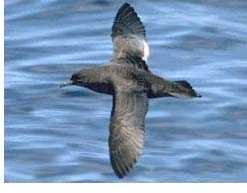Tasman Island is home to Australia's largest colony of Fairy Prions Pachyptila turtur with an island population that has been estimated at 300 000 - 700 000 pairs. The steep-sided (250-m high) 120-ha island lies just 1.2 km off Cape Pillar, near Hobart, Tasmania. It has been proclaimed an Important Bird Area by BirdLife International since its prion population forms over 1% of the estimated global population. It has been reported as supporting approximately 6000 pairs (range 3000-9000) of Short-tailed Shearwaters Puffinus tenuirostris and up to 1000 pairs of Sooty Shearwaters P. griseus. Common Diving Petrels Pelecanoides urinatrix may also breed. A 2005 survey yielded 5450 breeding pairs of Short-tailed Shearwaters and an estimate of 650 Sooty Shearwater pairs.

Short-tailed Shearwater. Photograph by Mark Carey
Unfortunately a population of about 50 feral cats Felis catus killed as many as 50 000 prions, shearwaters and other sea birds each year. The cats were introduced by lighthouse keepers during the early 1900s.
A programme to eradicate feral cats from the island, which forms part of the Tasman National Park, began in 2008. This came after an unsuccessful attempt to eradicate the cats over the period 1978-1983. Following a research and planning phase an eradication plan was produced in 2009.
Poison-baiting of the island was undertaken on 3 May 2010 with 960 baits containing PAPP (para-aminopropiophenone) set out by hand and dropped by helicopter. This was followed by trapping with cage and leg-hold traps and hunting with trained dogs which resulted in 28 more cats being killed. The last of the island's feral cats was trapped on 15 May 2010. Teams then visited the island each month for a year, checking the island for any sign of cats using remote infra-red cameras, cat-detecting dogs, spotlighting at night and scouring the island's plateau and steep boulder fields for cat signs such as fresh bird kills, scats or prints. The island was proclaimed to be cat free in June 2011 (click here).
See also http://www.discoverwildlife.com/tasmania/birds-triumph-over-cats
The eradication effort was undertaken by the Tasmanian Department of Primary Industries, Parks, Water and Environment (DPIPWE) with financial support from ecotourism operator Pennicott Wilderness Journeys via the Wildcare Tasmanian Coast Conservation Fund (click here). A Friends of Tasman Island group established in 2005 helps conserve the island and its historic buildings, including the lighthouse erected in 1906 and unmanned since 1977.
Sue Robinson (DPIPWE) has recently reported to ACAP that "Tasman Island looks good, with prions, shearwaters and rails increasing. Fairy Prion activity has more than doubled since the removal of cats and breeding success in Short-tailed Shearwaters has jumped from around 10% to over 70%. Lewin's Rail Lewinia pectoralis brachipus is now common on the island and several clutches of chicks have recently fledged."
Selected References:
Anon. 2010. Tasman Island cat eradication update. islandNet Newsletter 5: 5-6.
Brothers, N.P. 1979. Tasman Island. Corella 3: 55-57.
Brothers, N., Pemberton, D., Pryor, H. & Halley, V. 2001. Tasmania's Offshore Islands: Seabirds and other Natural Features. Hobart: Tasmanian Museum and Art Gallery. 643 pp.
Bryant, S.L. & Shaw, J. (Eds) 2006. Tasman Island: 2005 Flora and Fauna Survey. Hamish Saunders Memorial Trust, New Zealand and Biodiversity Conservation Branch, DPIW, Hobart, Nature Conservation Report Series 06/01.
Parks and Wildlife Service 2001. Tasman National Park and Reserves Management Plan 2001. Hobart: Parks and Wildlife Service. 110 pp.
Skira, I.J., Brothers, N.P. & Pemberton, D. 1996. Distribution, abundance and conservation status of Short-tailed Shearwaters Puffinus tenuirostris in Tasmania, Australia. Marine Ornithology 24: 1-14.
With thanks to Sue Robinson (DPIPWE) and Liz Znidersic (Charles Sturt University) for information and to Keith Springer and Sue for hosting me on the island for two nights in August 2009.
John Cooper, ACAP Information Officer, 5 February 2013

 English
English  Français
Français  Español
Español